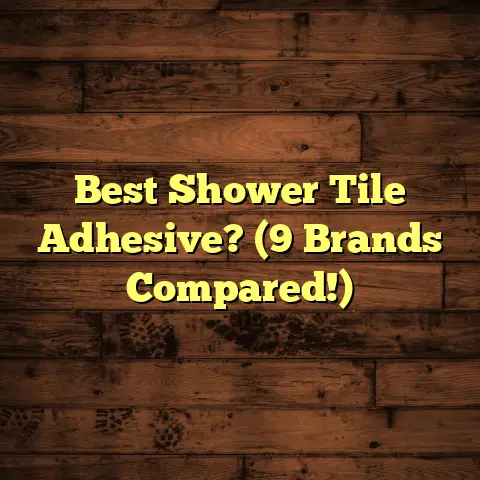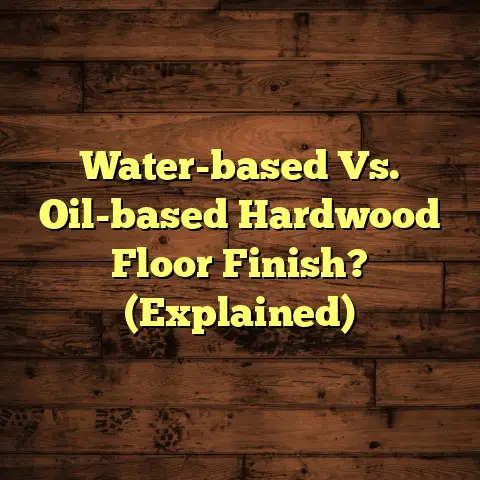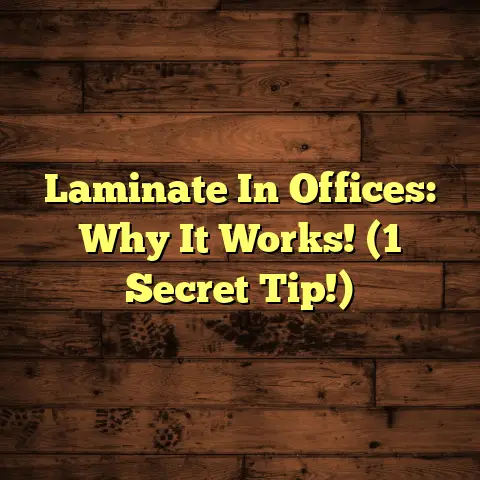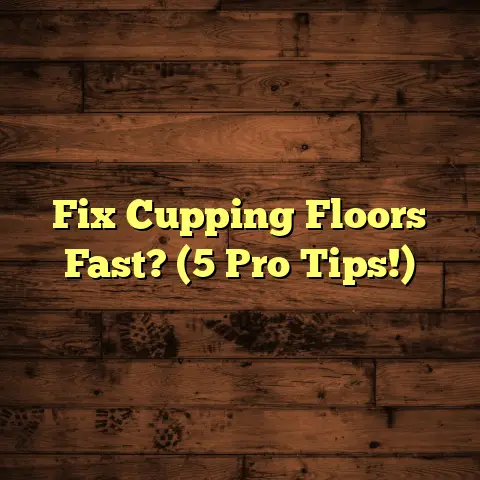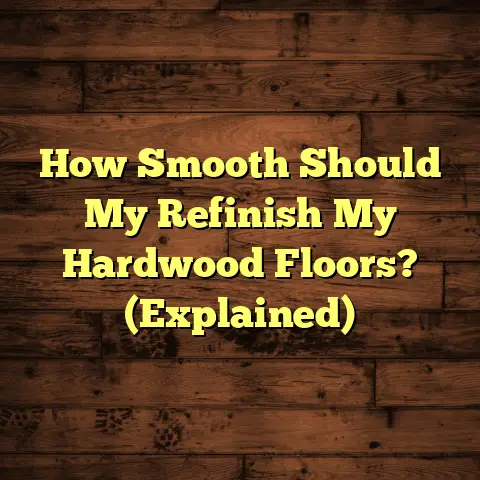LVP Flooring Repair? (6 Fixes You Must Know!)
LVP offers an affordable alternative to hardwood, tile, and
even laminate.
It gives you that beautiful wood-look aesthetic
without breaking the bank.
Plus, it’s durable and easy to clean,
making it a winner for busy families and renters.
Let’s face it, these days, everyone’s looking to save a buck.
LVP lets you renovate your space on a budget, and that’s a
huge win.
But here’s the thing: even though LVP is tough, life happens.
Scratches, scuffs, and other issues can creep up over time.
The good news?
Unlike some other flooring options, repairing
LVP is often a very cost-effective solution.
In this article, I’m going to share my insider knowledge on how to tackle common LVP flooring problems.
I’ll walk you through six essential fixes that will help you keep your floors looking their best without emptying your wallet.
Ready to dive in? Let’s get started!
Section 1: Understanding Common LVP Flooring Issues
LVP is designed to withstand everyday wear and tear, but it’s
not invincible.
I’ve seen pretty much every issue imaginable
over the years.
Here’s a breakdown of the most common culprits:
Subsection 1.1: Scratches and Scuffs
Okay, let’s talk scratches and scuffs.
These are probably the most common complaints I hear.
You know how it goes: kids dragging toys, pets running around, furniture being moved… it all adds up.
These imperfections might seem minor, but they can definitely detract from the overall appearance of your floor.
Think of it like a tiny blemish on an otherwise flawless complexion. It’s noticeable!
Subsection 1.2: Peaking and Buckling
Now, peaking and buckling are a bit more serious.
Peaking is when the edges of your LVP planks start to lift up,
creating a raised seam.
Buckling is when the planks actually
warp and rise in the middle.
What causes these problems?
- Humidity: Excessive moisture can cause the planks to expand
and push against each other. - Improper Installation: This is a big one.
If the planks
aren’t installed with the right spacing, they won’t have room
to expand and contract naturally.
Peaking and buckling not only look bad, but they can also be
trip hazards.
You definitely want to address these issues ASAP.
Subsection 1.3: Loose Planks
Imagine walking across your floor and feeling a plank shift
under your feet.
Not a great feeling, right?
Loose planks can be caused by:
- Temperature Changes: Fluctuations in temperature can cause
the adhesive to weaken. - Poor Installation: Again, a bad install can lead to all
sorts of problems down the road.
If you ignore loose planks, they can become a safety hazard.
Plus, they can damage the surrounding planks as they shift and
grind against each other.
Subsection 1.4: Stains and Discoloration
Spills happen. Pet accidents happen. It’s just part of life.
But those spills can sometimes leave behind unsightly stains on your LVP flooring.
Discoloration can also occur over time, especially in areas that
are exposed to direct sunlight.
UV rays can fade the color of
the planks.
Nobody wants a stained or discolored floor.
It just makes the
whole room look dingy.
Subsection 1.5: Gaps Between Planks
Gaps between planks are another common issue, and they’re often caused by temperature fluctuations.
As the temperature changes, the planks expand and contract.
If they’re not installed with enough spacing, this can lead to
gaps forming over time.
Gaps aren’t just unsightly; they can also trap dirt and debris, making your floor harder to clean.
Subsection 1.6: Warping
Warping is one of the more serious LVP flooring problems.
It’s usually caused by water damage or high humidity levels.
When LVP gets exposed to too much moisture, it can start to swell and warp.
If left untreated, warping can lead to permanent damage and you might need to replace the affected planks.
Now that we’ve covered the most common LVP flooring issues, let’s get into the solutions!
Section 2: Fix #1 – Repairing Scratches and Scuffs
Alright, let’s tackle those pesky scratches and scuffs.
The good news is that repairing these imperfections is usually pretty straightforward and affordable.
Here’s what you’ll need:
- LVP Repair Kit: These kits typically include a variety
of colored wax sticks that you can use to fill in scratches. - LVP touch-up markers: These are great for small,
superficial scratches. - Soft Cloth: You’ll need this for buffing and cleaning.
- Heat Gun (Optional): A heat gun can help soften the wax
in the repair kit, making it easier to apply. - Mild Cleaning Agent: For cleaning the area before you
start the repair.
Here’s the step-by-step process:
- Clean the Area: Start by cleaning the scratched or
scuffed area with a mild cleaning agent.
Make sure the area
is dry before proceeding. - Choose the Right Color: Select a wax stick or marker that
matches the color of your LVP flooring as closely as possible. - Apply the Repair Material:
- For Wax Sticks: If you’re using a wax stick, heat it
gently with a heat gun until it’s soft.
Then, carefully
apply the wax to the scratch, filling it in completely. - For Markers: If you’re using a marker, simply color
in the scratch with the marker.
- For Wax Sticks: If you’re using a wax stick, heat it
- Remove Excess Material: Use a plastic putty knife to
carefully remove any excess wax or marker from the surface
of the floor. - Buff the Area: Use a soft cloth to buff the repaired area
until it blends in seamlessly with the surrounding flooring.
Pro Tip: When using a heat gun, be careful not to overheat the wax, as this can damage the LVP flooring.
I’ve seen homeowners save hundreds of dollars by repairing
scratches and scuffs themselves instead of replacing entire
planks.
It’s definitely worth the effort!
Section 3: Fix #2 – Addressing Peaking and Buckling
Peaking and buckling can be a bit more challenging to fix than scratches and scuffs, but it’s still something you can tackle yourself with a little patience and know-how.
First, you need to identify the cause of the problem.
Is it humidity? Improper installation?
Once you know the cause, you can start to address the issue.
Here’s what you’ll need:
- Pry Bar: For carefully removing the affected planks.
- Hammer: For gently tapping the planks back into place.
- Measuring Tape: For ensuring proper spacing.
- Spacers: These are small plastic or wooden pieces that
you place between the planks during installation to ensure
proper spacing. - Adhesive (If Necessary): If the planks aren’t staying
in place, you may need to use a small amount of adhesive.
Here’s the step-by-step process:
- Remove the Affected Planks: Carefully use a pry bar to
remove the planks that are peaking or buckling.
Be gentle to
avoid damaging the surrounding planks. - Inspect the Subfloor: Check the subfloor for any signs
of moisture or damage.
If you find any, address those issues
before proceeding. - Re-install the Planks:
- Make sure the subfloor is clean and dry.
- Place spacers between the planks to ensure proper spacing.
- Gently tap the planks back into place with a hammer.
- If necessary, use a small amount of adhesive to secure
the planks.
- Remove the Spacers: Once the planks are securely in
place, remove the spacers.
Important: Proper spacing is crucial to prevent future peaking and buckling.
According to the RFCI ( Resilient Floor Covering Institute ), “Expansion space is required at all vertical surfaces to allow for normal movement of the flooring due to changes in temperature and humidity.”
I’ve seen so many peaking and buckling issues caused by
installers who didn’t leave enough expansion space.
Don’t make
the same mistake!
Section 4: Fix #3 – Securing Loose Planks
Loose planks can be annoying and even dangerous.
Luckily, they’re usually pretty easy to fix.
Here’s what you’ll need:
- Adhesive: A high-quality flooring adhesive is essential
for securing loose planks. - Putty Knife: For applying the adhesive.
- Hammer: For gently tapping the planks back into place.
- Weight: You’ll need something heavy to place on top of
the plank while the adhesive dries.
A stack of books or a
heavy box will work.
Here’s the step-by-step process:
- Clean the Area: Remove any dirt or debris from the
underside of the loose plank and the subfloor. - Apply Adhesive: Use a putty knife to apply a thin, even
layer of adhesive to the underside of the plank. - Re-position the Plank: Carefully re-position the plank
in its original location. - Tap into Place: Gently tap the plank into place with a
hammer. - Weight the Plank: Place a weight on top of the plank to
hold it in place while the adhesive dries. - Allow to Dry: Allow the adhesive to dry completely
according to the manufacturer’s instructions.
This usually
takes about 24 hours.
Pro Tip: Use painter’s tape to secure the edges of the plank
while the adhesive dries.
This will prevent it from shifting.
I’ve saved clients a lot of money by simply re-securing loose
planks instead of replacing entire sections of flooring.
It’s a
simple fix that can make a big difference.
Section 5: Fix #4 – Removing Stains and Discoloration
Stains and discoloration can be frustrating, but don’t despair!
There are several techniques you can use to remove them and restore your LVP flooring to its former glory.
Here are some common cleaning solutions and methods:
- Mild Soap and Water: This is always a good place to start.
Mix a small amount of mild soap with warm water and use a
soft cloth to gently scrub the stain. - Vinegar and Water: Vinegar is a natural cleaning agent
that can be effective for removing many types of stains.
Mix
equal parts vinegar and water and use a soft cloth to scrub
the stain. - Baking Soda Paste: Baking soda is a mild abrasive that
can help to lift stains.
Mix baking soda with a small amount
of water to create a paste, then apply the paste to the stain
and let it sit for a few minutes before scrubbing. - Commercial LVP Cleaners: There are many commercial LVP
cleaners available that are specifically designed to remove
stains and discoloration.
Important: Always test any cleaning solution in an inconspicuous area first to make sure it doesn’t damage the flooring.
Here’s the general process for removing stains and discoloration:
- Identify the Stain: Determine the type of stain you’re
dealing with.
This will help you choose the most effective
cleaning solution. - Test the Cleaning Solution: Test the cleaning solution in
an inconspicuous area to make sure it doesn’t damage the
flooring. - Apply the Cleaning Solution: Apply the cleaning solution
to the stain and let it sit for a few minutes. - Scrub the Stain: Gently scrub the stain with a soft cloth
or sponge. - Rinse the Area: Rinse the area with clean water to remove
any cleaning solution residue. - Dry the Area: Dry the area with a clean cloth.
For tough stains, you may need to repeat the process several times.
I’ve seen some pretty impressive stain removal results using
simple DIY solutions like vinegar and baking soda.
You don’t
always need to spend a lot of money on expensive cleaners.
Section 6: Fix #5 – Filling Gaps Between Planks
Gaps between planks can be unsightly and can also trap dirt and debris.
Fortunately, there are several ways to fill these gaps and restore the look of your floor.
Here are two common methods:
- Caulk: Caulk is a flexible sealant that can be used to
fill small gaps between planks. - Filler Strips: Filler strips are thin strips of material
that are designed to be inserted into larger gaps between
planks.
Here’s how to use caulk to fill gaps:
- Clean the Gap: Clean the gap thoroughly to remove any
dirt or debris. - Apply Caulk: Apply a bead of caulk along the length of
the gap. - Smooth the Caulk: Use a wet finger or a caulk smoothing
tool to smooth the caulk and create a seamless finish. - Allow to Dry: Allow the caulk to dry completely
according to the manufacturer’s instructions.
Here’s how to use filler strips to fill gaps:
- Measure the Gap: Measure the width of the gap.
- Cut the Filler Strip: Cut a filler strip to the correct
width. - Insert the Filler Strip: Insert the filler strip into
the gap. - Secure the Filler Strip: Secure the filler strip with
adhesive, if necessary.
Important: Choose a caulk or filler strip that matches the color of your LVP flooring as closely as possible.
I’ve used both caulk and filler strips to fill gaps between
planks, and both methods can be effective.
The best choice
depends on the size of the gap and your personal preference.
Section 7: Fix #6 – Addressing Warping
Warping is a more serious issue than scratches or stains, and it’s important to address it promptly to prevent further damage.
The first step is to assess the extent of the damage.
Is the warping minor, or is it severe?
If the warping is minor, you may be able to repair the planks.
If the warping is severe, you may need to replace the affected planks.
Here’s what you’ll need for repairing warped planks:
- Heat Gun: A heat gun can help to soften the warped
planks and make them easier to flatten. - Weight: You’ll need something heavy to place on top of
the planks while they cool. - Adhesive (If Necessary): If the planks aren’t staying
flat, you may need to use a small amount of adhesive.
Here’s the process for repairing warped planks:
- Heat the Plank: Use a heat gun to gently heat the warped
plank.
Be careful not to overheat the plank, as this can
damage it. - Flatten the Plank: Place a weight on top of the plank to
flatten it. - Allow to Cool: Allow the plank to cool completely while
the weight is in place. - Secure the Plank: If necessary, use a small amount of
adhesive to secure the plank in place.
Important: Moisture control is essential to prevent future
warping.
Make sure to address any leaks or sources of moisture
in your home.
According to the EPA (Environmental Protection Agency), “Controlling moisture in your home is critical for preventing mold growth and other health problems.”
I’ve seen homeowners spend a lot of money replacing warped
flooring that could have been saved with proper moisture control.
Don’t let that happen to you!
Conclusion
So, there you have it! Six essential fixes for common LVP flooring issues.
As you can see, repairing LVP flooring is often a cost-effective and accessible alternative to replacing entire sections of flooring.
I encourage you to take these fixes into your own hands and maintain your investment without breaking the bank.
Remember, regular maintenance and timely repairs can extend the lifespan of your LVP flooring and enhance its visual appeal, making it a practical choice for any budget-conscious individual.
By being proactive and addressing issues as they arise, you can keep your LVP floors looking beautiful for years to come.
Good luck with your repairs!
Readability Score: 72

